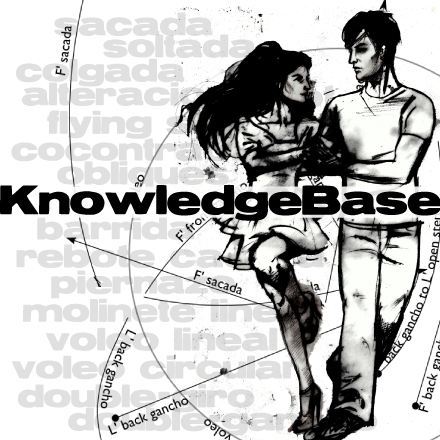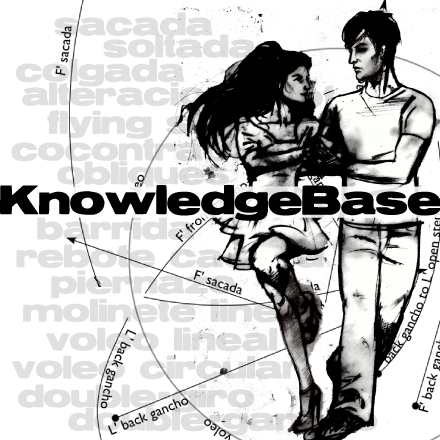An adorno is an adornment of a movement, like a decoration, made with the free leg. Both Marks and Revels adorn their movements.
Revels’ adornos include a large range of gestures, many of which can be marked. But we will use the term adorno for what is more precisely an “unmarked adorno”.
Since your free leg belongs to the Mark, you can only use it for your own purposes when he’s not using it!: On the way to a projection (without delaying it!) or when he gives you permission by holding the arch still and not showing you a projection.
Adornments are only permissable when they do not break the connection, endanger other dancers, distract or confuse your partner. This applies equally to Marks and Revels.
The Arch of Connection can provide space and permission to the partner to adorn. A revel should only do them if capable of doing them quickly and without disrupting her arc and the arch. Revels should start adorno practice when dancing very slowly and not attempt them at high speed until mastering adornos at slow speed. When dancing with a mark who does not create the arch of connection, a revel will need to be superfast to execute adornos. In turn, revels who build the arch well can inspire Marks to adorn.
The mark can end the adorno by initiating a projection. The revel must comply immediately, moving to the indicated projection. She should never delay or change his movement with an adorno.
A mark should only do an adorno if strong enough to hide it from the revel, so that she is not confused by his movement.
Adornos should only be done within your visual range to ensure you do not strike another dancer. (No back voleos!)
The adornos
All of the following can be done by both roles.
Adornos can be as simple as an extra extension on the way to a projection. For example, while walking backward, a dancer can extend to the front or to the side (with extended or flexed ankle – showing either toe or heel) before extending into to the next projection.
Dancers can draw circles on the floor, using either the heel or the toe. For the Mark this is called lapiz or pencil, and he can do it in a single giro. Use the free leg’s knee flexion to make the circle, keeping the foot touching the floor.
Taps of toe or heel are common in milonga and sparky rhythmic music. These taps can be close to the base leg or extended.
 Coupé (that’s a term from ballet) is a quick crosse at the ankle of the base leg. The cross can be made either front or back, with the free leg’s foot either pointed or flexed. During ochos, the pique can happen before or after the pivot. Extra fancy is a double coupé (one in front and one in back!)… When the Mark does this during giro, it’s called enrosque.
Coupé (that’s a term from ballet) is a quick crosse at the ankle of the base leg. The cross can be made either front or back, with the free leg’s foot either pointed or flexed. During ochos, the pique can happen before or after the pivot. Extra fancy is a double coupé (one in front and one in back!)… When the Mark does this during giro, it’s called enrosque.
Kicks between the partners legs are known as patada. Revel’s patada is usually marked.
Tiny changes of foot must be executed in even numbers (ending on the original base leg) while keeping the arc pointed in exactly the same place so there is no disruption to the arch.
Front voleo and passe are overused as Revel’s adornos. Be expressive, not habitual.
Fan adds knee flexion to a pivot. Before starting the pivot, draw the knees to touch and flex the free one a lot, then pivot with the foot in the air. After the pivot, extend the knee to put the foot on the floor and continue to the projection. This should only be done when the dance floor is not crowded.
Butterfly adds hip rotation to a pivot. See separate entry on butterfly voleo.
Adornos Walking
div style=”text-align:center; width:100%;”>
Adornos to ocho











